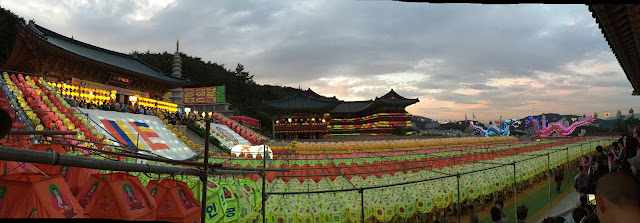Every May, the Lotus Lantern Festival takes place at the Samgwangsa Temple to commemorate Buddha's birthday. It is a spectacular time to visit as the entire temple grounds will be lit up with lanterns and floats.
As we visited on a Saturday evening, the roads leading up to the temple were severely congested. The traffic police tried to stop cars from going anywhere near the temple entrance. We had to alight some distance away from the temple and our taxi driver was extremely apologetic that he couldn’t bring us all the way up to the entrance. No worries though, we managed to make our way up a steep hill on our own (after breaking out a bit of sweat).
A funny thing happened to us while we were walking up to the temple. We were stopped by an ahjumma near the parking lot. She was carrying several plastic bags and she fished out something and passed it to us – it was red bean buns! We were like “HUH, what’s going on” and tried to tell her “gwenchanayo” and shook our heads, but she wouldn’t take “no” for an answer. She was insistent that we take the food! Haha! So weird! We didn’t know what was going on but thanked her for it anyway.
 |
| steps leading up to the temple were decorated with zodiac lanterns |
Although we had already seen one Lotus Lantern festival at Haedong Yonggungsa the day before, the festival at Samgwangsa is on a whole new different level altogether. We were really, really fortunate to visit Busan during Buddha’s birthday because we get to see Samgwangsa Temple at its most beautiful.
Thousands of brightly lit lotus lanterns were strung across the temple grounds, together with many other creative lantern displays such as the twelve animals of the zodiac. Some of them can even move and breathe fire! WOW! Needless to say, this stunning display of lanterns attracted many devotees, curious tourists and hardcore photographers alike. It’s really impossible to take a lousy photograph here. The best time to visit would be in the evening, where you can see the sight in both its daytime and night-time glory.


When we left, we realised that the temple was distributing bread, bananas and drinks to devotees and many locals were seen leaving the temple with humongous bags of food. I guess this is where the ahjumma we met earlier got the red bean buns!
 |
| red bean buns that we ate for breakfast the next day |
Clutching our precious anpan in our hands, we made our way downhill to catch a cab back to Seomyeon. We grabbed a late dinner and did a bit more shopping before returning back to our hotel. Another wonderful day in Busan. Saranghaeyo Busan!
 |
| dinner was seafood udon with loads of bonito flakes |
How to get there:
Take the subway to Seomyeon station and take a taxi (about 5,000 won) to the temple. Alternatively, you can take the mini bus No. 15 at the bus stop across from the Lotte Department store in Seomyeon. Get off at the entrance of Samgwangsa temple.



















































